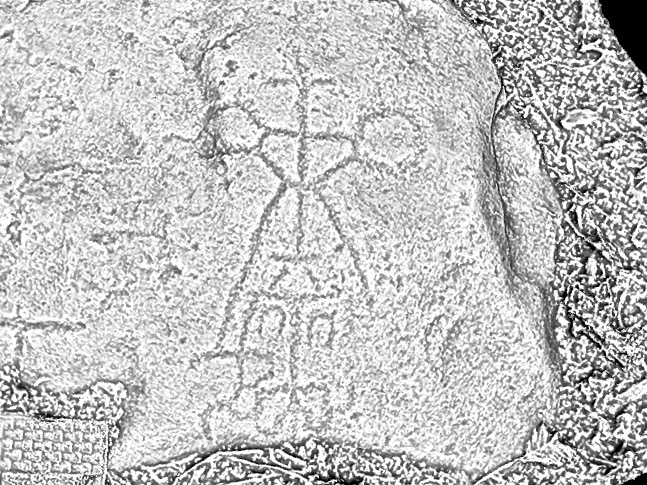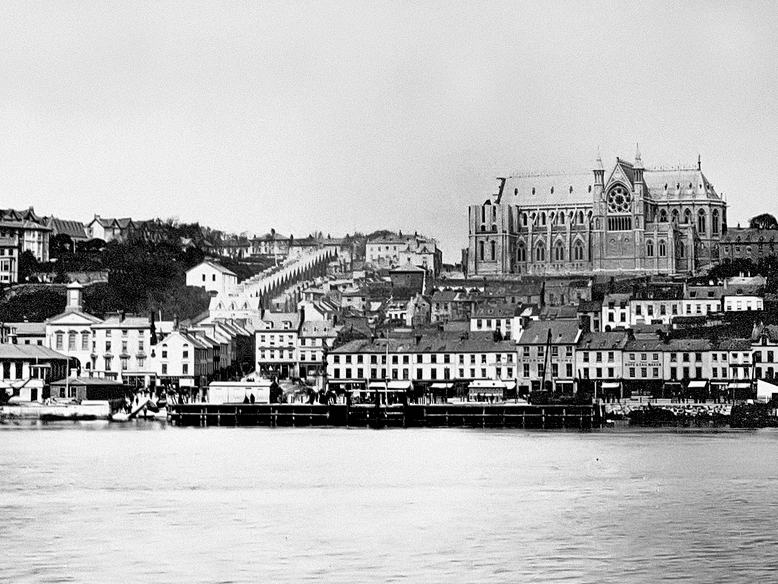An exciting discovery by Robert has led us on yet another journey – this time to the Dingle Peninsula in the Early Medieval period. But the journey started in Adare Manor and I don’t think it’s finished yet. Let me explain…
Our Christmas present to each other was a two night stay in Adare Manor – a favourite place full of history. Robert has written about a previous stay there when he was overwhelmed by the Gothic architecture and I wrote about our falconry experience. This time, we spent much time wandering the extensive and beautiful grounds. There’s a small grove of trees between the house and the golf club and this is where the Adare Manor collection of Ogham stones are located. These fine examples of Ogham, all of which came from Co Kerry originally, have been located at the Manor since the early nineteenth century. In recent years the grove has been cleaned up (older photos show it to have been quite overgrown and brambly) and the stones themselves have been straightened and cleaned. (Read more about Ogham in this post from a few years ago by Robert.)
Robert spotted a flat slab lying in the ground among the stones. He has developed a keen eye for anything resembling a carving (remember his find at Inish Beg?) and called me over to look more closely. We took several photographs, trying to get the best light to show up the carvings – a difficult task underneath the trees. It was obviously something, and vaguely reminiscent of Early Medieval (or Early Christian as it used to be called) carvings we had seen elsewhere, but odd and indistinct.
Noting that there was no record of anything except Ogham stones at this location in the National Monuments inventory, I sent photographs to Chris Corlett, an archaeologist with the National Monuments Service and an authority on the Early Medieval period. He responded that he was pretty certain it was from that period and forwarded the correspondence to Caimin O’Brien, the NM archaeologist with responsibility for Limerick. That’s where we started to get some answers. Caimin immediately recognised the carving from an 1865 book!
The book is Memorials of Adare Manor by Caroline, Countess of Dunraven (it’s available online at that amazing resource, archive.org). Caimin sent me a screen print, from which it was obvious that this was the same stone. The Dunravens, like many educated people in the nineteenth century, were interested in antiquities of all sorts. They are referenced here and there as ‘rescuing’ ancient artefacts and stones from damage, and Lady Dunraven goes to some pains to explain that none of the pieces that ended up in the museum at Adare Manor were in situ when they were acquired.
Four cross-inscribed stones are described in the book, all of which came from the Dingle Peninsula in West Kerry, or Corca Dhuibhne, from the area around Ballyferriter, west of Dingle. It’s an area that is unusually rich in Early Medieval sites – Reask, Gallarus and Kilmalkader are only three of the well known monastic ruins. Of those four stones, three are now back in West Kerry and on display. Until we found it, however, nobody had any idea what had happened to the fourth stone!
Imaged above and below are the cross-inscribed pillar that came from Reask in the early 1800s – and returned there in the 1970s
The late Tom Fanning excavated the Reask site (Riasc, in Irish) in the 70s and it is now a monument in state care, carefully reconstructed to suggest what an early monastic site would have looked like. One of the Adare stones had come from Reask and it was sent back to the reconstructed site “. . .through the kind offices of Lord and Lady Dunraven.” My photographs are below, but if you want to see it in 3D, click here.
A group of Americans were enacted some kind of ritual at the Reask monastic site when I was there. There was a lot of shouting about darkness and light and and dancing in a circle
Two others of the original four also arrived back in West Kerry and are both now at the Músaem Corca Dhuibhne in Ballyferriter, under the knowledgeable care of Isabel Bennett, the curator, pictured below with the second cross-inscribed stone). I am assuming that the stones were returned at the same time as the pillar now at Reask. Isabel has poured over all the available documentation but, like me, she can’t quite figure out when or why the transfers were made.
The more elaborate of the two came from Reask, but may have been considered too worn to be displayed outdoors. I give Lady Dunraven’s drawing below (although I am not sure who actually did the drawings – it may have been our old friend George Victor du Noyer). You can view a 3d rendering here.
The smallest of the stones (below) is triangular in shape and came originally from the townland of Killvickadownig, a few kilometres south of Reask, near Ventry. There’s a faint carving of a cross on the back, but the front bears a lovely four-armed cross with curled ends. The stone appears to have been detached or broken off from something else.
But our piece, the Adare Manor cross-inscribed stone, where did it come from and why is it, alone of the four, still at Adare? Well, it appears from Lady Dunraven’s account that the stone came from Ballydavid (Baile Daith), not too far from the other stones, and ‘close to a ringfort.’ Caimin has now uploaded the record (screenshot below) with a provisional original location near the only ringfort in Ballydavid, but noting of course that the stone is located in Adare Manor.
I can find no explanation as to why this stone was left at Adare Manor when the others were moved. It seems that the Reask pillar was located among the Ogham stones also, while the other two may have been indoors. Perhaps our Ballydavid slab was covered in moss and brambles to the extent that it was simply overlooked. Whatever the reason, I am glad to have been part of the rediscovery of this curious stone. I never cease to be amazed at the variety of forms these early cross slabs take, and this one is certainly unusual. While a cross shape forms the upper core of the carving, the central part reminds me of the monks’ habits that you see on occasional high crosses, such as the ones at Kilfenora. But what about all those squiggles at the bottom? I can make no sense of them.
Nick Hogan of the Dept of Archaeology at University College Cork had graciously taken the images I sent and turned them into a 3D rendering: the image below is a still from that process. My photogrammetry skills need refining but he still managed to create an image that is clearer than any photograph.
A close-up of the carved area. The grid at bottom left is part of a scale-arrow
There are still unanswered questions in this story, but the biggest unanswered question – Where is the fourth stone? – has at least been answered.
Still from a 3D render of the cross-inscribed stone
It’s been a fascinating bit of detective work to piece the story together and many people have contributed their expertise generously, particularly Chris Corlett, Caimin O’Brien, Nick Hogan and Isabel Bennet, while Sarah Ormston of the Adare Manor Hotel facilitated our access to the slab for recording purposes. Our thanks to all of them.






























































































